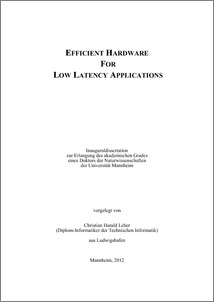|
Efficient hardware for low latency applications
Leber, Christian
![[img]](https://madoc.bib.uni-mannheim.de/style/images/fileicons/application_pdf.png)  Vorschau |
|
PDF
thesis_christian_leber_print-1.pdf
- Veröffentlichte Version
Download (2MB)
|
|
URL:
|
https://ub-madoc.bib.uni-mannheim.de/32403
|
|
URN:
|
urn:nbn:de:bsz:180-madoc-324030
|
|
Dokumenttyp:
|
Dissertation
|
|
Erscheinungsjahr:
|
2012
|
|
Ort der Veröffentlichung:
|
Mannheim
|
|
Verlag:
|
Universität Mannheim
|
|
Hochschule:
|
Universität Mannheim
|
|
Gutachter:
|
Brüning, Ulrich
|
|
Datum der mündl. Prüfung:
|
20 August 2012
|
|
Sprache der Veröffentlichung:
|
Englisch
|
|
Einrichtung:
|
Fakultät für Wirtschaftsinformatik und Wirtschaftsmathematik > Rechnerarchitektur (Brüning 1996-2008)
|
|
Fachgebiet:
|
004 Informatik
|
|
Normierte Schlagwörter (SWD):
|
Hardwareentwurf , Speicherverwaltung , Mikroprogrammierung , Latenz , Kommunikationsprotokoll
|
|
Freie Schlagwörter (Englisch):
|
Computer Architecture , Low Latency , Micro Programming , Microcode Engine , Memory Management , Translation Lookaside Buffer , High Performance Computing , Remote Memory Access , Hardware Design , TCP/IP , Co-Simulation , Automatic Code Generation
|
|
Abstract:
|
The design and development of application specific hardware structures has a
high degree of complexity. Logic resources are nowadays often not the limit
anymore, but the development time.
The first part presents a generator which allows defining control and status
structures for hardware designs using an abstract high level language.
A novel method to inform host systems very efficiently about changes in the
register files is presented in the second part. It makes use of a microcode
programmable hardware unit.
In the third part a fully pipelined address translation mechanism for remote
memory access in HPC interconnection networks is presented, which features a new
concept to resolve dependency problems.
The last part of this thesis addresses the problem of sending TCP messages for a
low latency trading application using a hybrid TCP stack implementation that
consists of hardware and software components. Furthermore, a simulation
environment for the TCP stack is presented.
|
 | Das Dokument wird vom Publikationsserver der Universitätsbibliothek Mannheim bereitgestellt. |
 Suche Autoren in Suche Autoren in
Sie haben einen Fehler gefunden? Teilen Sie uns Ihren Korrekturwunsch bitte hier mit: E-Mail
Actions (login required)
 |
Eintrag anzeigen |
|
|
